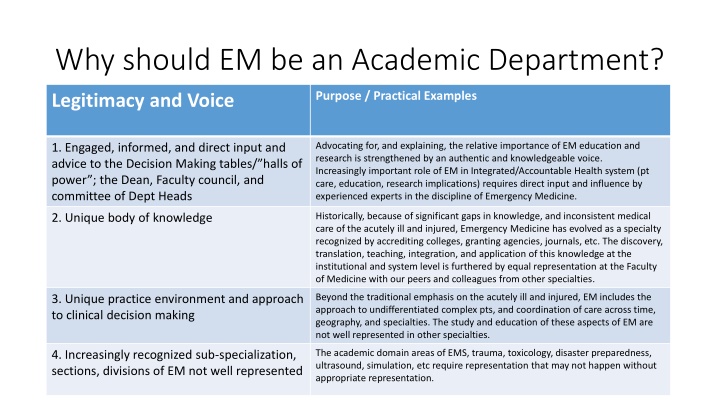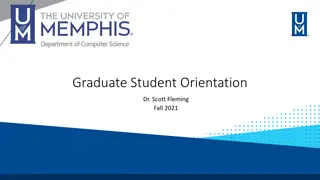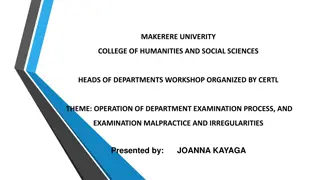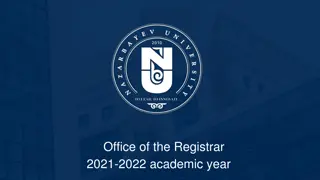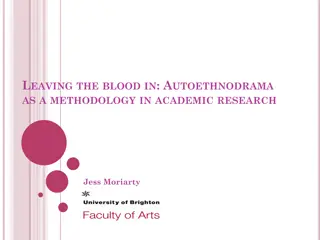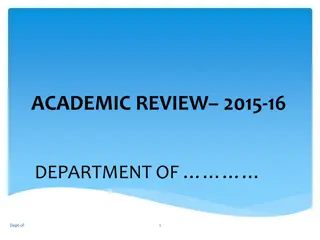Why should EM be an Academic Department?
Advancing the field of Emergency Medicine through education, research, and advocacy. Strengthening legitimacy and voice, addressing unique knowledge and practice areas, and enhancing performance metrics for research programs.
Download Presentation

Please find below an Image/Link to download the presentation.
The content on the website is provided AS IS for your information and personal use only. It may not be sold, licensed, or shared on other websites without obtaining consent from the author.If you encounter any issues during the download, it is possible that the publisher has removed the file from their server.
You are allowed to download the files provided on this website for personal or commercial use, subject to the condition that they are used lawfully. All files are the property of their respective owners.
The content on the website is provided AS IS for your information and personal use only. It may not be sold, licensed, or shared on other websites without obtaining consent from the author.
E N D
Presentation Transcript
Why should EM be an Academic Department? Purpose / Practical Examples Legitimacy and Voice Advocating for, and explaining, the relative importance of EM education and research is strengthened by an authentic and knowledgeable voice. Increasingly important role of EM in Integrated/Accountable Health system (pt care, education, research implications) requires direct input and influence by experienced experts in the discipline of Emergency Medicine. 1. Engaged, informed, and direct input and advice to the Decision Making tables/ halls of power ; the Dean, Faculty council, and committee of Dept Heads Historically, because of significant gaps in knowledge, and inconsistent medical care of the acutely ill and injured, Emergency Medicine has evolved as a specialty recognized by accrediting colleges, granting agencies, journals, etc. The discovery, translation, teaching, integration, and application of this knowledge at the institutional and system level is furthered by equal representation at the Faculty of Medicine with our peers and colleagues from other specialties. 2. Unique body of knowledge Beyond the traditional emphasis on the acutely ill and injured, EM includes the approach to undifferentiated complex pts, and coordination of care across time, geography, and specialties. The study and education of these aspects of EM are not well represented in other specialties. 3. Unique practice environment and approach to clinical decision making The academic domain areas of EMS, trauma, toxicology, disaster preparedness, ultrasound, simulation, etc require representation that may not happen without appropriate representation. 4. Increasingly recognized sub-specialization, sections, divisions of EM not well represented
Why should EM be an Academic Department? Strategic Direction Purpose / Practical Examples Increasingly important role of EM education, research, and role in Integrated/Accountable Health systems requires direct participation and influence in University and Health Science Centre/Network priority setting. 1. Engaged, informed, and direct input and advice to the Strategic Planning of the FoM, AHSC Reduce the confusion within our own discipline, and especially from the perspective of other specialties, on who is EM anyways? , what do they do? Who is speaking for EM? And change the narrative from either/or debates to both/and solutions (with implications to physician resource planning and clinical services planning). 2. Vehicle to unify the EM strategic planning, priority setting, and synergistic support of FRCP, PEM, and CCFP-EM Paradoxically, in order to be better integrated into the future plans of the FoM/AHSC an independent, collaborative, and direct presence of EM is necessary and will see more inter-dependancies, potential synergies, and therefore, catalyze more system innovations, research, and education opportunities. 3. Differentiate and Integrate (as opposed to subspecialize and fragment) Long history of appropriateness <..> and health services optimization < > research in EM may be seen as strategically important to the Dean/FoM. Future of Medical Education in Canada white papers emphasize the importance of generalist approaches again a traditional strength of EM. 4. Increasing emphasis on research funding opportunities in patient outcomes research and generalist approaches to medical education
Why should EM be an Academic Department? Purpose / Practical Examples Performance (effectiveness, efficiency, responsiveness) As measured by metrics such as grant applications, successful grant funding, publications, impact factors, presentations, awards, and development of national and international research programs/coalitions. 1. Improve performance of Research program. (Scholarship of Discovery) As measured by metrics such as new curriculum development and delivery, teaching assessments/evaluations, accreditations, innovations, awards, and peer reviewed publications of education research. 2. Improve performance of Education program. (Scholarship of Teaching) Defined as giving meaning to isolated facts, putting them in perspective, making connections across disciplines, placing the specialties in a larger context, illuminating data in a revealing way . As measured by the breaking down of traditionally siloed problem solving (across medical specialties, and across broader domains of study), catalyzing and communicating health care innovations in complex adaptive systems <..>. 3. Improving performance in the Scholarship of Integration (Boyers) 4. Improving performance in the Scholarship of Application (Boyers) Defined as applying knowledge to consequential problems to help individuals and institutions, problems themselves become the scholarly agenda . Through the rigours of a scholarly approach, Academic Health Science centres improve system design, population outcomes and optimize costs through approaches such as implementation science and patient outcome research.
Why should EM be an Academic Department? Accountability and Transparency Purpose / Practical Examples Often the largest group of like-minded FTEs in the Faculty of Medicine without Departmental status. Size itself, reflecting a critical mass, (in combination with all the other reasons) is a compelling reason to give a voice. Otherwise, diversity of perspective (as an initiator of dialogue and change) potentially stifled by layers of bureaucracy. 1. Large group / critical mass of practitioners, educators, and researchers with potentially unclear understanding of parent Dept values, priorities, policies and financial allocations Departmental status may have privileges (potentially more funding and influence) but it will have more responsibilities (more teaching, higher expectations of research productivity etc). Emergency Medicine, as a specialty, is ready for that challenge. 2. Accountability to Dean s UGME education needs/priorities, Increased research productivity The Chair +/- leadership team may require a more balanced (clinical and academic) flow of funding to meet expectations of the Dean and the mission of the Faculty of Medicine. Again, Emergency Medicine, as a specialty, is ready for that challenge. 3. Dept practice plan aligned with mission/vision of Dept and FoM Lack of representation of EM may make sense from a historical and political perspective in the halls of academia, but a marginalized EM in an increasingly publically accountable system may not pass the sniff test for public expectations and public funders. 4. University and FoM is accountable to the public and DoH
Why should EM be an Academic Department? Purpose / Practical Examples Equity and Fairness EM may not know what we don t know around what sources of funding may be available. Incentivizing strategic priorities of interest to EM may be under-represented in creating competitive streams of funding. 1. Direct and objective input into the types of funding opportunities Eliminate bias baked in to the rules by helping to write the rules so that EPs can compete with other academic peers on an equal footing. Likewise, Dept can compete for HR support and/or equipment, infrastructure, and office space based on merit and fairness. 2. Direct and objective input into the rules around applying for sources of funding With dept status there will be increased understanding and influence over academic promotion criteria and outcomes. What it is exactly that EM does? How that may be valued in academic promotion pathways <..> 3. Promotions criteria, pathways, and policies of EM Dept better aligned with the FoM There may be different (perhaps more stringent) search and survey criteria in the FoM bylaws for a Chair search and dept review which may lead to more involvement and input from University and FoM leaders (catalyzing higher level candidates and improved dept performance). 4. Criteria and expectations of search and survey process of Dept vs Div
Why should EM be an Academic Department? Purpose / Practical Examples General/Other 85% of medical schools in the US now have full academic Departments of EM status <..> A rising tide floats all ships (Dept status may improve profile of EM across Canada). Institutional recognition (as per other high profile schools: Johns Hopkins, Mayo, Brown, Yale, Harvard, etc) Likewise in Canada. Departmental status is seen as a natural evolutionary step in the maturation of a specialty. 1. Compelling arguments have convinced the majority of Medical Schools / Faculty councils across North America Departmental status may help in recruiting better residents, better faculty (researchers and educators), better Leaders and Chairs. Many mid career or higher profile researchers/educators may not go backwards . 2. Improved recruitment and retention Pursuing departmental status can be an act of professional/discipline of EM self advocacy (where self represents the unique and important perspectives of EM) in service of broader organizational goals, and ultimately improved patient care. Unfortunately in some contexts (including with funders, policy makers, and the public) there is still ignorance around what EM is and the strength of its academic output. 3. Departmental status as an act of Professional Identity Formation <..> with organizational culture changing impact It can also be a way to engage faculty in seeing themselves and the academic division/unit as an important and influential body within the future vision of the Medical School and the Academic Health Science centre. Branding may be helpful in philanthropy initiatives. 4. Departmental status as an act of branding
